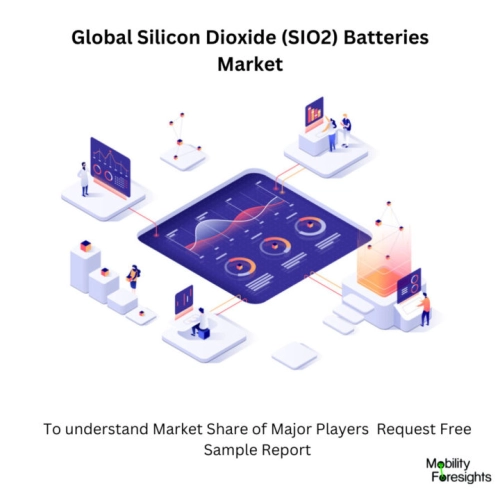
- Get in Touch with Us

Last Updated: Apr 25, 2025 | Study Period: 2023-2030
SiO2 batteries, often known as lead crystal batteries or just crystal batteries, are made to withstand harsh environments.
These batteries have longer lives and can withstand deeper discharges, more frequent cycling (even in very hot or very cold conditions).
They regain their maximum rated capacity. They may be stored for up to two years without recharging and don't require maintenance, specific ventilation, or cooling.
SiO2 batteries retain more power at lower temperatures and are not damaged by freezing.Low temperatures will result in a capacity reduction in SiO2 batteries, although not to the point of freezing.
A SiO2 battery can be used up to 100% of its capacity. For instance, a 100Ah SiO2 battery will have 60Ah of usable power at -30C/-22F since the battery retains 60% of its capacity (3x power vs. Lead Acid).
At high temperatures, SiO2 batteries perform better than the majority of batteries. They are rated to +65C/149F as opposed to lead acid's 45-50C/113-122F rating.
At 50% DoD, SiO2 Batteries outlast by up to five times (depth of discharge). At 50% depths of drain, deep-cycle lead acid batteries have ratings ranging from 500 charge/discharge cycles for budget batteries to 1200 cycles for premium batteries (DoD).
The SiO2 batteries have an 8â12 year service life based on up to a 30â50% daily discharge rate and a substantially greater cycle life of 2800 cycles at 50% DoD. In comparison to most deep-cycle batteries, their lifetime cost per cycle ranges from 0.5 to 0.3.

Global Silicon Dioxide (SiO2) Batteries market accounted for $XX Billion in 2022 and is anticipated to reach $XX Billion by 2030, registering a CAGR of XX% from 2023 to 2030.
Chicago-based NanoGraf Technologies announced that it will open the nation's first large-scale silicon oxide factory.
The company claims to have made it possible for the 18650 lithium-ion cell to be the world's most energy-dense battery. 35 tonnes will be produced annually by NanoGraf at its maximum capacity.
The 18-month contract with the DoD enables NanoGraf to deliberately scale up domestic production. NanoGraf deliberately chooses the path of cautious growth.
The company plans to supply domestically produced batteries to the EV market by 2024, when it hopes to reach its target of producing 1,000 tonnes of silicon anode material annually. Hund believes that this methodical step sets the stage for the company's next stage.
| Sl no | Topic |
| 1 | Market Segmentation |
| 2 | Scope of the report |
| 3 | Abbreviations |
| 4 | Research Methodology |
| 5 | Executive Summary |
| 6 | Introduction |
| 7 | Insights from Industry stakeholders |
| 8 | Cost breakdown of Product by sub-components and average profit margin |
| 9 | Disruptive innovation in the Industry |
| 10 | Technology trends in the Industry |
| 11 | Consumer trends in the industry |
| 12 | Recent Production Milestones |
| 13 | Component Manufacturing in US, EU and China |
| 14 | COVID-19 impact on overall market |
| 15 | COVID-19 impact on Production of components |
| 16 | COVID-19 impact on Point of sale |
| 17 | Market Segmentation, Dynamics and Forecast by Geography, 2023-2030 |
| 18 | Market Segmentation, Dynamics and Forecast by Product Type, 2023-2030 |
| 19 | Market Segmentation, Dynamics and Forecast by Application, 2023-2030 |
| 20 | Market Segmentation, Dynamics and Forecast by End use, 2023-2030 |
| 21 | Product installation rate by OEM, 2023 |
| 22 | Incline/Decline in Average B-2-B selling price in past 5 years |
| 23 | Competition from substitute products |
| 24 | Gross margin and average profitability of suppliers |
| 25 | New product development in past 12 months |
| 26 | M&A in past 12 months |
| 27 | Growth strategy of leading players |
| 28 | Market share of vendors, 2023 |
| 29 | Company Profiles |
| 30 | Unmet needs and opportunity for new suppliers |
| 31 | Conclusion |
| 32 | Appendix |